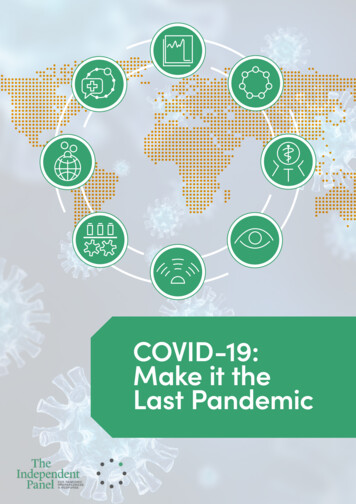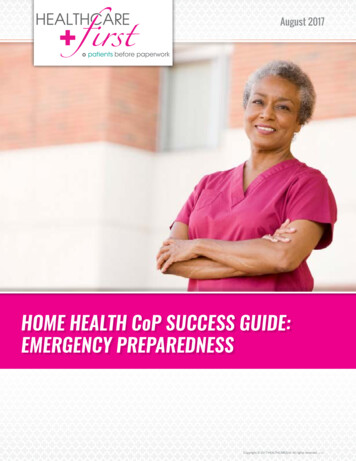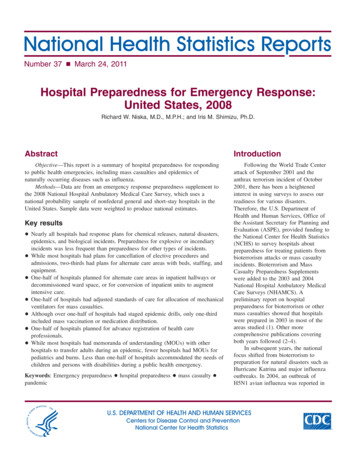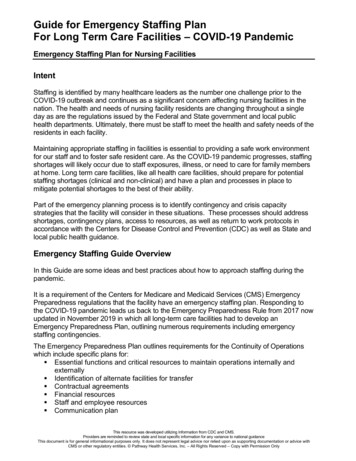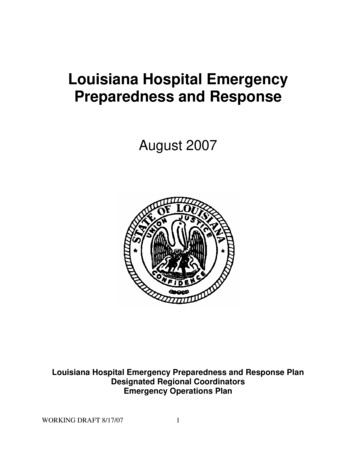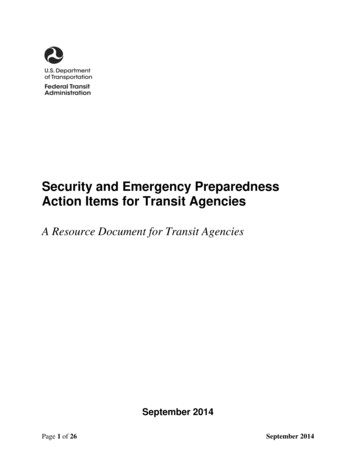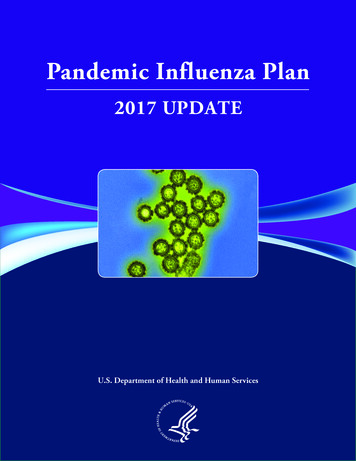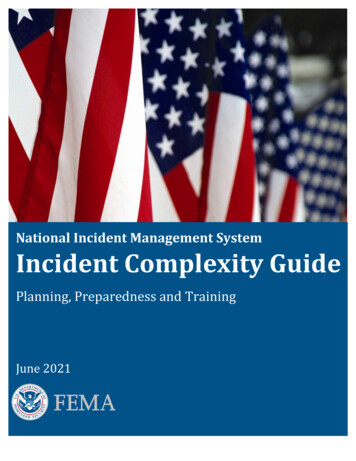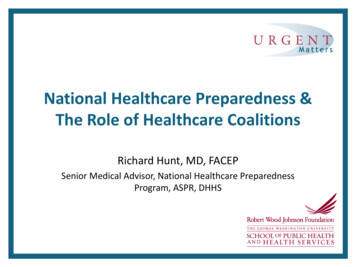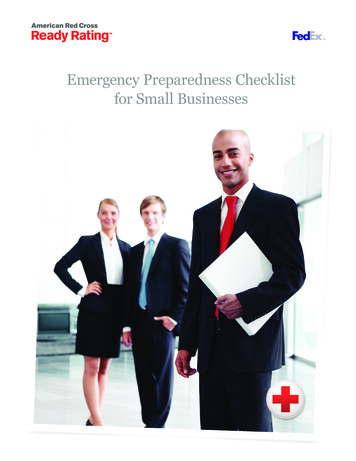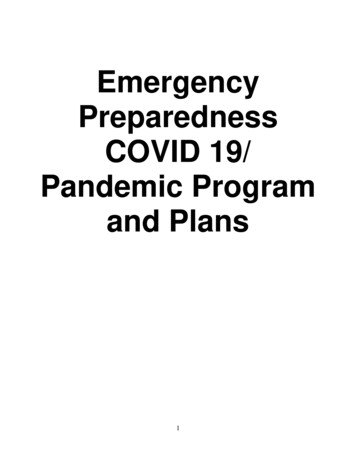
Transcription
EmergencyPreparednessCOVID 19/Pandemic Programand Plans1
Policy: Emergency Preparedness Program – Pandemic(COVID 19) PlanDate:E Tag – E-001Objective:The primary objective of this manual is to provide a means for safeguarding the residents, staffand visitors related to a Pandemic Outbreak.This COVID-19 Emergency Preparedness Procedure Guide is provided to coordinate activitieswithin LeRoy Village Green Nursing and Rehabilitation Center Nursing & Rehabilitation Centerduring the Pandemic national and state emergencies.A copy of this plan is available to viewed either at the Facility or on the Facility’s website.2
Table of ContentsSection 1: Incident Management/CommunicationPage 4Section 2: Infectious Disease PolicyPage 8Section 3: Separation-Quarantine ZonePage 23Section 4: Screening ConductPage 28Section 5: StaffingPage 42Section 6: COVID-19 Additional PoliciesPage 46Section 7: Nursing Home Incident CommandPage 58AppendicesAppendix A: Federal Regulations – QSO Notice 20-20-NFPage 68Appendix B: NHICS Job Action SheetsPage 100Appendix C: OtherPage 1393
Section 1IncidentManagementTeam&COMMUNICATION4
Policy: Pandemic (COVID 19) CommunicationsDate:E Tag – E-0029Objective:The primary objective is to provide a means for safeguarding the residents; protect theemployees and safeguard the facility; and to establish procedures for receiving and handlingdisasters.Policy:Every facility is expected to have an Incident Management Team which is the predeterminedgroup of individuals who may serve the incident command functions. Typically, the IncidentCommander will determine the size and composition of the IMT, including who is available; thedemands created by the incident; etc.Incident Management Team for LeRoy Village Green Nursing and Rehabilitation Center isas follows:1. Samantha Vagg, Administrator2. John Waldron, Facilities Manager3. Jennifer Trigilio, Director of NursesTYPEPOLICEFIRESTATE SURVEY AGENCYDAYTIME #STATE SURVEY AGENCY24 HOUR #LOCAL PUBLIC HEALTHAGENCYLOCAL EMERGENCYMANAGEMENT AGENCYAMBULANCE COMPANY #1: [AMBULANCE COMPANY #2:PARATRANSIT OR OTHERTRANSPORTATIONEXTERNAL CRITICAL CONTACTSTEL #/ EMAILCONTACT NAME(585) 345-3000SHERIFF-GENESEECOUNTY(585) 345-3000NYS POLICE911 (585) 768-2527LEROY FIRE DEPT(716) 847-4320NYS DEPT OF HEALTHBUFFALO REGIONAL866-882-2809NYS DEPT OF HEALTH(585) 344-2580 EXT 5555(585) 768-2600GENESEE COUNTY DEPTOF HEALTHGENESEE COUNTYEMERGENCY MGMTLEROY AMBULANCE1-888-637-2935MERCY AMBULANCE(585) 343-3079BATAVIA BUS SERVICE(585) 344-00785
POWER COMPANYGAS COMPANYTELEPHONE ATER SYSTEM(585) 442-2000SEWER SYSTEM(585) 768-2527FIRE ALARM SYSTEMFIRE PROTECTIONSPRINKLER SYSTEMSECURITY ALARMSYSTEMEMERGENCY WATERSUPPLYEMERGENCY FOODSUPPLY(585) 739-6787(585) 739-6787NATIONAL GRIDRG&EFRONTIERCOMMUNICATIONSMONROE COUNTYWATER AUTHORITYVILLAGE of LeRoyOFFICESolution One, Inc.Solution One, Inc.N/ALVG STORAGE UNITDIETARYInternal CommunicationsLeRoy Village Green Nursing and Rehabilitation Center Nursing & RehabCenterDepartment Head ListTitleAdministratorPhone –Ext#Samantha Vagg(585) 768-2561212Jennifer Trigilio, RNLisa Wehner, RNJennifer Marzolf, LPNStephanie Loewke, LPNMarie Hart, RNBetty Janiszeski, RNAngela Brewer, RNRobin Easton(585) 768-2561(585) 768-2561(585) 768-2561(585) 768-2561(585) 768-2561(585) 768-2561(585) 768-2561(585) 768-2561241217202209249200217217Lisa MiccicheMary Ann Wortman(585) 768-2561(585) 768-2561214213NameNursingDirector of NursingAssistant Director of NursingA Unit ManagerB Unit ManagerC Unit ManagerD Unit ManagerRN Evening SupervisorRN Night SupervisorSocial WorkDirector of Social ServicesSocial Worker6
Other DepartmentsActivities DirectorAdmissions CoordinatorBusiness OfficeDieticianDining Services DirectorEducationDirector of FacilitiesDirector of Environmental ServicesHuman ResourcesMDS CoordinatorMedical DirectorRehab Director (Physical Therapy)Katrina FlintSamantha VaggAlicia AndrewsJoan KeenanSue DiFilippoKim ArnoldJohn WaldronNancy WrightCrystal RhinehartJoanna Huntz, RNRaja Kolisetti, MDNick Stravakos(585) 768-2561(585) 768-2561(585) 768-2561(585) 768-2561(585) 768-2561(585) 768-2561(585) 768-2561(585) 768-2561(585) 768-2561(585) 768-2561(585) 768-2561(585) ication Plan – Residents/Family Members/GuardiansLeRoy Village Green Nursing and Rehabilitation Center has developed as part of the PandemicEmergency Plan a plan to communicate with Residents/Family Members/ Guardians. The Facility will update authorized family members and guardians of residents infectedwith the pandemic disease within 24 hours of the disease being identified and at leastdaily thereafter and upon a change of condition. All residents and authorized family members and guardians will be updated at leastweekly on the number of infections and deaths related to the pandemic illness. Residents will be provided access to free remote video conferencing or similarcommunication as needed in order for them to communicate with family members orguardians. The communication to authorized family members will be in electronic form unlessanother method is selected by the family member or guardian. Samples methods ofelectronic communication are, Cell phone, land line telephone, text messages and email. The facility will modify the frequency or method of the communication based on anyRegulatory Agency guidance.7
Section 2Infectious DiseasePolicies8
Policy: Infectious DiseasesDate:E Tag – E-0013/E-0015PolicyTo protect our residents, families, and staff from harm resulting from exposure to an emergentinfectious disease while they are in our facility.General Preparedness for Infectious DiseasesLeRoy Village Green Nursing and Rehabilitation Center emergency program includes aresponse plan for a community-wide infectious disease outbreak such as COVID-19, SARS,influenza and alike. This plan includes:1. Build on the workplace practices described in the Infection Prevention and Control Program(IPCP)2. The annual review of the IPCP policies and practices3. Include administrative controls (screening, isolation, visitor policies and employee absenteeplans).4. Review of the surveillance and antibiotic stewardship programs.5. Review influenza/pneumococcal immunization of residents.6. Address environmental controls (isolation rooms, plastic barriers, sanitation stations, andspecial areas for contaminated wastes).7. Address human resource issues such as employee leave following all Regulatoryrequirements.8. Be compatible with the facility’s business continuity plan.9. Incident Commander or individual(s) will monitor and evaluate the emerging situation andinform staff and others as needed on potential risks of new infections in their geographiclocation through the changes to existing organisms and/or immigration, tourism, or othercircumstances.10. As part of the emergency operations plan, the facility will maintain a supply of appropriatepersonal protective equipment (PPE). LeRoy Village Green Nursing and RehabilitationCenter will maintain a supply of PPE as required by State requirements.11. LeRoy Village Green Nursing and Rehabilitation Center and its purchasing department willdevelop plans with their vendors for re-supply of food, medications, sanitizing agents andPPE in the event of a disruption to normal business including an infectious diseaseoutbreak/pandemic.12. The facility will inform staff and provide training for employees and practice the infectiousdisease response plan through drills, competencies, and exercises as part of the facility’semergency preparedness training.13. The Facility will comply with all reporting requirements issued by the CDC, CMS, State andLocal Departments of Health9
Threat1. Once notified by the public health authorities at either the federal, state and/or local level thatthe infectious disease is likely to or already has spread to the facility’s community, the facilitywill activate specific surveillance and screening as instructed by Centers for Disease Controland Prevention (CDC), The Centers of Medicare and Medicaid (CMS) and/or the State/localpublic health authorities.2. The facility’s Incident Commander along with individuals appointed by the IncidentCommander to work with the facility’s medical director, pharmacy provider and others to bestunderstand the specific signs, symptoms, incubation period, and route of infection, the risksof exposure, and the recommendations for skilled nursing facilities as provided by the CDC,CMS and other relevant local, state and federal public health agencies.3. Working with advice from the facility’s medical director or clinical consultant, safety officer,human resource director, local and state public health authorities, and others as appropriateand will review and revise internal policies and procedures, stock up on medications,environmental cleaning agents, and PPE as indicated by the specific disease threat.4. Staff will be educated on the exposure risks, symptoms, and prevention of the infectiousdisease. Place special emphasis on reviewing the basic infection prevention and control, useof PPE, isolation, and other infection prevention strategies such as hand washing.5. Provide residents and families with education about the disease and the facility’s responsestrategy at a level appropriate to their interests and need for information.6. Brief contractors, vendors and other relevant stakeholders on the facility’s policies andprocedures related to minimizing exposure risks to residents.7. Post signs regarding hand sanitation and respiratory etiquette and/or other preventionstrategies relevant to the route of infection at the entry of the facility along will the instructionthat anyone who is sick must not enter the building.8. To ensure that staff, and/or new residents are not at risk of spreading the infectious diseaseinto the facility, screening for exposure risks, signs and symptoms will be done PRIOR toadmission of a new resident and at least prior to the employee starting their work shift.9. Staff will be educated on the facility’s plan to control exposure to the residents. This plan willbe developed with the guidance of local public health authorities and may include:1. Self-isolation - in the event there are confirmed cases of the infectious disease in thelocal community, the facility may consider closing the facility to new admissions, andlimiting visitors based on the advice of the local CDC, CMS or public healthauthorities.2. Environmental cleaning - the facility will follow current CDC guidelines forenvironmental cleaning specific to the infectious disease in addition to routinecleaning for the duration of the threat.10. Place a resident who exhibits symptoms of the infectious disease in a room with the doorclosed until further assessment is completed.11. If an employee exhibits symptoms of the infectious disease during the screening process,place them in a separate room, notify the Infection Preventionist/DON and proceed perscreening guidelines. If an employee exhibits symptoms of the infectious disease during theirwork shift, immediately remove them from the work area into a separate room. Notify theInfection Preventionist/DON for further guidance and recommendations.10
12. Under the guidance of public health authorities, encourage follow up with the employee’sphysician for testing and or treatment or arrange a transfer of the suspected infectiousperson to the appropriate acute facility via emergency medical services if employee isacutely ill and requiring emergency services as soon as possible.13. If the suspected infectious person requires care while awaiting transfer, follow facility policiesfor isolation procedures, including all recommended PPE for staff at risk of exposure.14. Keep the number of staff assigned to enter the room of the isolated person to a minimum.Ideally, only specially trained staff and prepared (i.e. vaccinated, medically cleared and fittested for respiratory protection) will enter the isolation room. Provide all assigned staffadditional “just in time” training and supervision in the mode of transmission of this infectiousdisease, and the use of the appropriate PPE.15. If feasible, ask the isolated person to wear a facemask while staff is in the room. Providecare at the level necessary to address essential needs of the isolated individual unlessadvised otherwise by public health authorities.16. Conduct control activities such as management of infectious wastes, terminal cleaning of theisolation room, contact tracing of exposed individuals, and monitoring for additional casesunder the guidance of local health authorities, and in keeping with guidance from the CDC.17. Implement the isolation protocol in the facility (isolation rooms, cancelation of group activitiesand social dining) as described in the facility’s infection prevention and control plan and/orrecommended by local, state, or federal public health authorities.Employer ConsiderationsFacility management will consider its requirements under CMS and state licensure, and otherstate or federal laws in determining the precautions it will take to protect its residents. Protectingthe residents and other employees shall be of paramount concern. Management shall take intoaccount:1. The degree of frailty of the residents in the facility.2. The likelihood of the infectious disease being transmitted to the residents and employees.3. The method of spread of the disease (for example, through contact with bodily fluids,contaminated air, contaminated surfaces).4. The precautions which can be taken to prevent the spread of the infectious disease andother relevant factors.5. Once these factors are considered, management will weigh its options and determine theextent to which exposed employees, or those who are showing signs of the infectiousdisease, must be precluded from contact with residents or other employees.6. Apply whatever action is taken uniformly to all staff in like circumstances.7. Do not consider race, gender, marital status, country of origin, and other protectedcharacteristics unless they are documented as relevant to the spread of the disease.8. Make reasonable accommodations for employees such as permitting employees to workfrom home if their job description permits this.9. Generally accepted scientific procedures, whenever available, will be used to determine thelevel of risk posed by an employee.10. Permit employees to use sick leave, vacation time, and FMLA where appropriate while theyare out of work.11
11. Permit employees to return to work when cleared by a licensed physician, however,additional precautions may be taken to protect the residents.12. Employees who refuse at any time to take the precautions set out in this and other sectionsof this policy may be subject to discipline.DefinitionsInfectious disease - whose incidence in humans has increased in the past two decades orthreatens to increase in the near future. These diseases, which respect no national boundaries,include:1. New infections resulting from changes or evolution of existing organisms2. Known infections spreading to new geographic areas or populations3. Previously unrecognized infections appearing in areas undergoing ecologictransformation4. Old infections reemerging as a result of antimicrobial resistance in known agents orbreakdowns in public health measuresPandemic - A sudden infectious disease outbreak that becomes very widespread and affects awhole region, a continent, or the world due to a susceptible population. By definition, a truepandemic causes a high degree of mortality.Isolation - Separation of an individual or group who is reasonably suspected to be infected witha communicable disease from those who are not infected to prevent the spread of the disease.Quarantine - Separation of an individual or group reasonably suspected to have been exposedto a communicable disease but who is not yet ill (displaying signs and symptoms) from thosewho have not been so exposed to prevent the spread of the disease.Infection Control Policies:Pandemic (COVID 19) Infection Control- New YorkC IC 28dLast DateReviewed/Revised:7/9/20203-14-20; 3-19-20, 46-20; 4-22-20; 5-11NewPrev. DateDept:Clinical OperationsReviewed/Revised:Revised X20, 5-14-20,6/12/20Creation Date:3-11-20CMS/CDC/State/Local DOH Guidance- Employee screening form C IC 28b, VisitationRELATED FORMS:CV 512
Policy: The facility has established appropriate guidelines pursuant to recommendations from the LocalPublic Health, State Department of Health, CMS and the Federal Centers for Disease Control (CDC). Thepolicy addresses resident, staff and visitor behavior and responsibilities to try to prevent thetransmission of communicable diseases, such as undiagnosed respiratory illness and COVID-19.The facility has the necessary means to provide adequate care to residents and will not deny anadmission or re-admission solely on a resident diagnosed with Pandemic illiness but will followCMS/CDC/State/Local DOH guidance.NY facilities- A resident will not be admitted or re-admitted to the facility until a negative molecular testfor SARS-Cov-2 RNA is completed and sent with hospital admission paperwork.COVID 19 InformationCorona Viruses are a large family of viruses, some causing illness in people and others circulating amonganimals including camels, cats, and bats and at times evolves and infects people before spreadingthrough human to human contact.The 2019 novel corona virus (COVID -19) is a new virus that causes respiratory illness in people and canspread from person to person. The virus was first identified during an investigation in Wuhan, China.Risk:Risk of infection with COVID -19 is higher for people who are close contacts of someone known to haveCOVID -19, for example healthcare workers or household members. Others at higher risk for infectionare those who live in or have recently been in an area with ongoing spread of COVID-19.Symptoms:Per CDC, prompt detection, triage, and isolation of potential infectious residents are essential to preventunnecessary exposures among residents, healthcare personnel (HCP) and visitors at the facility.Symptoms may appear in as few as 2 days or as long as 14 days after exposure. Reported illnesses haveranged from people with little to no symptoms to being severely ill and dying.Common signs and symptoms* fever* cough* Shortness of breathLess common signs and symptoms* confusion or change in mental status. If noted, check pulse oximetry for O2 Sats* muscle aches, headache* sore throat, runny nose* chest pain* diarrhea, nausea and vomiting* myalgia* chills; chills with shaking* sudden onset of loss of taste/smellHuman corona virus spreads just like the flu or cold:* through the air by cough/sneezing13
* close personal contact such as touching or shaking hands* touching an object or surface with the virus on it* occasional fecal contamination* possible spread thru just speaking, (still not proven fact)Healthcare personnel (HCP) are on the front lines of caring for patients with confirmed or possibleinfection with undiagnosed respiratory illness and coronavirus disease 2019 (COVID-19) and thereforehave an increased risk of exposure to this virus. HCPs can minimize their risk of exposure when caring forconfirmed or possible COVID-19 patients by following CDC infection prevention and control guidelines,including use of recommended personal protective equipment (PPE).Procedure:1. The facility, consistent with federal regulations, implements universal, standard infection controlpractices. This may include information pertaining to:* Standard Precautions* Transmission Based Precautions* Hand hygiene* Respiratory hygiene* Vaccinations* Signs and symptoms of common communicable diseasesTo prevent the spread of respiratory germs WITHIN the facility, monitor/screen employees for feveror respiratory symptoms. The screener should wear PPE following CMS and DOHrecommendations during the screening process. For COVID -19 screening, the facility willmonitor employee temperatures prior to starting shift and at end of shift or based on Statespecific DOH guidance. Refer to employee screening tool C IC 28 for additional screeningrequirements.a.Restrict residents with fever or acute respiratory symptoms to their room. If they mustleave the room for medically necessary procedures, have them wear a facemask (iftolerated). Obtaining a pulse ox on the resident may need completed based on respiratorystatus. A physician order will be obtained with specific information for completion.b.In general, for care of residents with undiagnosed respiratory infection and COVID-19 useStandard, Contact, and/or Droplet Precautions with appropriate PPE based onTransmission-based Precautions (gown, gloves, mask/eye protection, N95) unlesssuspected diagnosis requires Airborne Precautions (e.g., tuberculosis). When COVID-19 is14
identified in the facility, staff wear all recommended PPE (gloves, gown, eye protection,and respirator or face mask) for the care of all residents on the unit (or facility-wide basedon the location of affected residents), regardless of symptoms (refer to CDC guidelines forconservation and use of PPE).c.The facility monitors the Federal CDC website and state and local health sources tounderstand COVID-19 activity in their community to help inform their evaluation ofindividuals with unknown respiratory illness. If there is transmission of COVID-19 in thecommunity, in addition to implementing the precautions described above for residentswith acute respiratory infection, the facility shall also consult with local health authoritiesfor additional guidance.d.Signs should be posted throughout the facility describing ways to prevent the spread ofgerms. s/stop-the-spread-ofgerms.pdfe.Hand and respiratory hygiene as well as cough etiquette by residents, visitors, andemployees is imperative. Everyone is encouraged to wash their hands using soap andwater or hand sanitizer frequently.f.Employees are educated and reminded to clean their hands according to CDC guidelines,including before and after contact with residents, after contact with contaminated surfacesor equipment, and after removing personal protective equipment (PPE).g.Put alcohol-based hand rub in common areas, including hallways. Encourage staff,residents and visitors to wash hands with soap and water or to use the hand sanitizerfrequently.h.It is recommended that tissues are available and any sink is well-stocked with soap andpaper towels for hand washing.i.If able, the facility will identify and cohort utilizing separate areas of the facility or adesignated wing/unit to provide care for residents with COVID -19. Also, if able, the facilitywill identify a designated wing/unit to monitor new admissions/readmissions residentsthat may have been exposed to COVID prior to admission.j.If able, the facility will identify dedicated employees to care for COVID-19 patients andprovide infection control training. A log/assignment sheet will be maintained for thoseemployees providing care.k.Post signs on the door or wall outside of the resident room that clearly describe the type ofprecautions needed and required PPE.15
l.Make PPE, including facemasks, eye protection, gowns, and gloves, available outside of theresident room or close proximity to resident room when it’s determined PPE is needed forthe resident.m.Position a trash can near the exit in the resident room to make it easy for employees todiscard PPE. Perform hand hygiene upon exiting patient rooms.n.The Administrator, in conjunction with the Medical Director and Infection Preventionist,has the authority to restrict or ban facility visitation and communal dining, group activitiesduring outbreaks (epidemic, pandemic), whether these originate in the facility or in thecommunity. The Facility will follow guidance recommended by Federal and Governmentagencies as it relates to restriction of visitors.o.Visitors are discouraged at all times from visiting when they have potentially contagiousinfections (for example, upper respiratory infection (URI), influenza, gastroenteritis, orunexplained rashes).p.Visitors who are symptomatic of communicable diseases, undiagnosed respiratory illnessand COVID-19 will be denied visitation at the discretion of the Administrator, DON and/orCharge Nurse and/ or as designated as an emergency proclamation by the State untilappropriate evaluation and treatment of the visitor has been established. Signs should beposted at entrance doors and throughout facility reminding visitors of these symptomrisks.q.Visitors/HCP shall be encouraged to wash their hands upon arrival and when leaving thefacility, and passively instructed on proper cough etiquette/ respiratory hygiene throughsigns posted throughout the facility and upon screening.r.Visitors are expected to adhere to instructions from the Administrator, DON and/or ChargeNurse on duty regarding facility infection control practices and visitation restrictions.s.The facility reserves the right to remove/restrict all resident independent communityaccess passes during the COVID-19 emergency.t.All new Admissions or Re-Admissions will be tested for Covid-19 prior to discharge fromacute care setting, or any other setting, test results must be NEGATIVE and a part of thedischarge paperwork. All Residents sent out to the hospital will return when medicallyclear and a NEGATIVE COVID-19 test was obtained. If they can’t return to their previousroom the resident will be placed in a temporary room for 14days then return to theirprevious room with all their belongings.2. Steps to promote health and safety:a. Stay home when sick.b. Avoid touching your eyes, nose and mouth16
c. Cover your cough or sneeze into your elbow, or if unable, then use a tissue, then throwthe tissue in the trash.d. Clean and disinfect frequently touched objects and surfaces using an approved/recommended cleaning product.e. Wash your hands often with soap and water for at least 20 seconds or utilize handsanitizer.f. Avoid close contact with people who are sickg. Follow public health advice regarding school closures, avoiding crowds and other socialdistancing measures.h. Stay informed. CDC’s COVID-19 Situation Summary will be updated regularly asinformation becomes available.3. Visitor restriction will be followed based on Federal and State guidance. Visitor guidance could berecommended as “Restricting”, “Limiting”, and “Discouraging”; refer to CMS guidance related todefinitions of each recommendation. Examples of “limiting” visitors are noted below:a. Those visiting a person with dementia (e.g., to lend support, ease anxiety, help theperson feel safe/secure/grounded if staff are not able to comfort resident).b. Those visiting a hospice patient or end of life resident.c. Those visiting who are able to lend a patient “psychosocial support.”4. Facilities who are notified of a resident in the facility or recently transferred to the hospital andnotified by the hospital that a resident tested positive for COVID 19, need to follow guidance for careof that resident/residents based on CDC and Local and State Health Departments. These agencies areto be notified of a presumptive positive or confirmed positive resident for further guidance of care.CEO/COO/Regional Clinical Nurse/VP Buildings & Grounds should be notified of any Suspicious,Presumptive Positive or Positive resident.5. Violations of these policies shall be reported to the Administrator. The Administrator has the rightto remove, restrict or ban visitors as indicated.6. If the facility is unable to provide adequate care to a Resident at any time during the resident’sstay, the facility must call their respective regional office of the Department of Health to providenecessary information and assist with any relocation needs if needed, including but not limited toassistance with arranging transportation to an alternate facility that can provide adequate carefor the resident.Discontinuation of Transmission-Based Precautions for Residents with COVID-1917
Transmission-based precautions are used by healthcare facilities to care for patients with confirmed or probableCOVID-19, or in response to known or suspected exposure to COVID-19. These guidelines apply to healthcarefacilities where transmission-based precautions are used.The decision to discontinue Transmission-Based Precautions for patients with confirmed COVID-19should be made using either a test-based strategy or a symptom-based (i.e., time-since-illness onset andtime-since-recovery strategy) or time-based strategy as described below. Meeting criteria fordiscontinuation of Transmission-Based Precautions is not a prerequisite for discharge.Symptomatic residents with COVID-19 should remain in Transmission- Based Precautions UntilEither:Test-based strategyo Resolution of fever without the use of fever-reducing medications ando Improvement in respiratory symptoms (e.g., cough, shortness of breath), ando Negative results of an FDA Emergency Use Authorized COVID-19 molecular assay for detection of SARS-CoV-2RNA from at least two consecutive swab specimens collected 24 hours apart (total of two negative specimens)Symptom-based strategyleast 3 days (72 hours) have passed since recovery defined as resolution of fever without the useof fever-reducing medications ando At* Improvement in respiratory symptoms (e.g., cough, shortness of breath); and,* At least 10 days have passed since symptoms first appearedResidents with laboratory confirmed COVID 19 who have not had any symptoms should remain inTransmission-based Precautions until either:Test-based strategyo Negative results of an FDA Emergency Use Authorized COVID-19 molecular assay for detection of SARS-CoV-2RNA from at least two consecutive specimens collected 24 hours apart (total of two negative specimens).oNote, because of the absence of sympto
SHERIFF -GENESEE COUNTY NYS POLICE FIRE 911 (585) 768-2527 LEROY FIRE DEPT STATE SURVEY AGENCY DAYTIME # . Director of Social Services Lisa Micciche (585) 768-2561 214 Social Worker Mary Ann Wortman (585) 768-2561 213 . Working with advice from the facility's medical director or clinical consultant, safety officer, human resource director .
